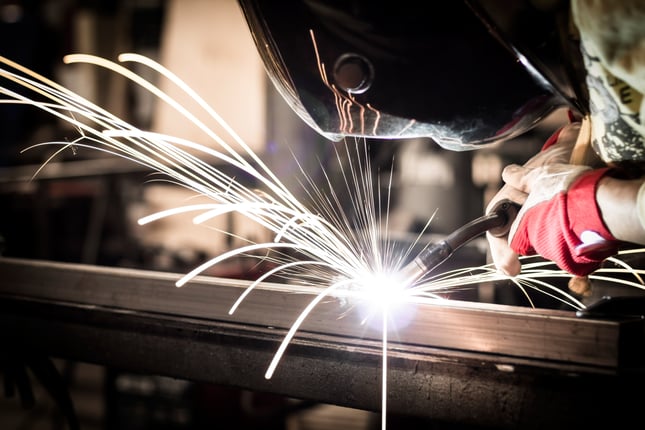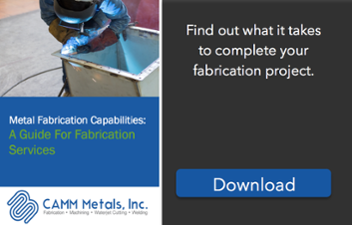Welding is an important part of the metal fabrication process. However, there are many different issues that can arise from welding. Without proper technique, there are many different problems that can occur. Here are some of the most common problems that occur with welding and how to fix them.

1. Spatter
Spatter occurs when droplets of molten material are produced near welding arc. This issue typically occurs during gas metal arc welding (GMAW). This issue is typically the result of currents that are too high, incorrect polarity, or insufficient gas shielding. There are a few different things that welders can do to help avoid spatter. Reducing the welding current and arc length can help avoid spatter, along with increasing the torch-to-plate angle. You should also double check that the polarity, shielding gas type, and flow rates are all correct. Cleaning the gas nozzle can also help avoid spatter.
2. Porosity
Porosity is caused by absorption of nitrogen, oxygen, and hydrogen in the molten weld pool, which is then released on solidification to become trapped in the weld metal. Porosity in a weld can be caused by the presence of moisture, rust, grease, or paint of the plate edges. It can also be caused by insufficient gas shielding and when welding is done onto small gaps with air in between. There are a number of ways to avoid porosity in a weld, such as re-baking, using fresh welding consumables, and having dry and clean plate edges. You should also check the welding torch for leaks and make sure the torch to plate angle is the correct size. Cleaning the gas nozzle of the welding device will also help avoid this issue.
3. Undercut
An undercut can occur when the arc voltage is too high or the arc is too long. It can also happen with incorrect electrode usage or an incorrect angle, as well as using an electrode that is too large for the thickness of the plate. Using a travel speed that is too quick can also lead to an undercut. In order to avoid this issue, watch the speed of the weld, monitor how much weave is used, and avoid holding the electrode near the vertical plate when making a horizontal fillet weld. You should also avoid using an electrode bigger than needed, as an undercut can occur if the amount of molten metal becomes too big.
4. Deformation
Deformation can occur during the contraction of welded metals when cooling and hardening. It can happen when the welding sequence is not suitable for the intended weld, there are too many thin beads, or there is insufficient clamping before welding. To avoid deformation, weld from both sides of the joint and be sure to weld from the center out, in opposite directions. Use a large electrode and clamp firmly. Change the sequence of the welds and location of the joint if deformation begins to occur. Making fewer passes during welding can also help avoid deformation.
5. Cracks
Cracks are an issue with welding, as they can become larger over time. Fixing a crack is not as simple as filling the gap with material. Cracks need to be ground out and a new weld needs to be performed in order to correct the error. For this reason, preventing cracks is easier than fixing them. In order to prevent cracks, you should spend the proper amount of time grinding, cleaning, filing, and deburring the edges of plates so they fit together easily. You should reheat both sides of the joint, making sure the temperature is correct. You should also check to make sure you have the right amount of heat before welding by testing your machine settings.
6. Incomplete Penetration and Fusion
Incomplete root fusion occurs when the weld fails to fuse on one side of the joint in the root. Incomplete root penetration occurs when both sides of the roof region of joints are unfused. These issues tend to occur during more consumable electrode processes where the weld is automatically deposited as the arc consumes the electrode wire or rod. These processes typically including MIG, MAG, FCAW, MMA, and SAW welding. Solutions to these issues include use of a wider root gap and use of electrodes whose diameter size is about the gap width of the root. When welding, you should use lower travel speed and weave between the plate edges.
7. Slag Inclusions
Slag inclusions occur when small particles of flux become trapped inside the weld metal, preventing complete penetration of the weld. The best way to prevent this issue is to have well maintained flux-coated consumables. It’s also important to make sure the current, voltage, and arc are all correct.
8. Incorrect Wire Delivery
This issue will typically result in a chattering sound with the gun cable. It is often caused by incorrect set up of equipment, incorrect maintenance, or welders using tips too large for application. In order to prevent incorrect wire delivery, check the size of the tips before welding, make sure the tips are not worn out and do not need to be replaced, and check that the drive rolls and guide tubes are in close proximity to one another.
9. Brittle Welds
Another common issue with welding is the creation of brittle welds that do not hold up. Bare electrodes or electrodes of the incorrect size can lead to brittle welds. In order to produce ductile welds, be sure to use shielded arc electrodes, avoid using excessive current, and pass over the weld several times.
CAMM Metals | CT Welding Services
In order to ensure your welding comes with minimal distortion, call in the professionals! As a CT welding contractor, we specialize in MIG & TIG welding of Steel, Stainless Steel and Aluminum and use Pulsed welding machines to help control the heat put into a part, minimize distortion, and improve the quality of the parts we produce.
After the welding is complete, we offer many in-house services. These services include, weld inspection with dye penetrant, acid cleaning and polishing of stainless steel welds. Additionally, we are also able to weld and test watertight enclosures.For those customers who require certified welds, we can certify our welds to AWS D1.1 & AWS D1.6.



